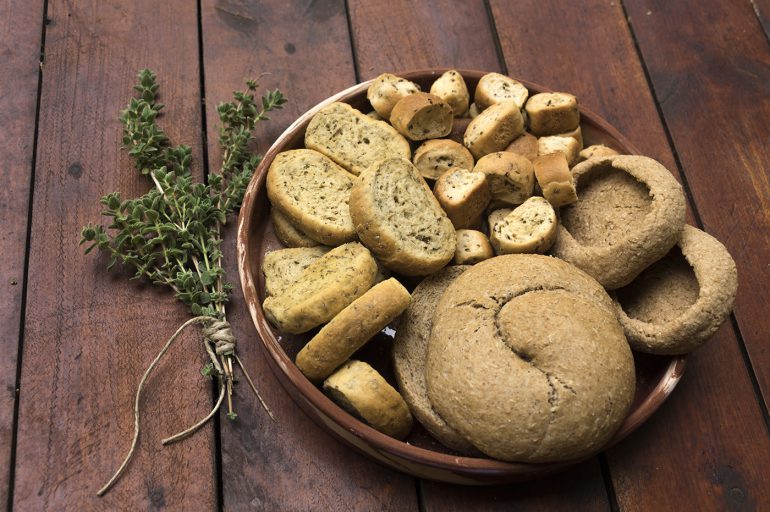Crete, the largest of the Greek islands, is a place where history, culture, and culinary traditions converge. Among the many delights that Crete has to offer, traditional Cretan rusks, known locally as “dakos” or “paximadi,” stand out as a symbol of the island’s rich heritage and timeless cuisine. These hard, twice-baked bread slices are a staple of the Cretan diet, cherished for their simplicity, versatility, and nutritional value. This text explores the history, preparation, and cultural significance of Cretan rusks, inviting you to discover the authentic flavors of Crete.
The History of Cretan Rusks
The origins of Cretan rusks can be traced back to ancient times, reflecting the ingenuity and resourcefulness of the island’s inhabitants. In a region where food preservation was crucial for survival, rusks emerged as a practical solution.
1. Ancient Beginnings: Rusks have been a part of Cretan cuisine since the Minoan civilization (circa 2600 to 1100 BC). The Minoans, known for their advanced agricultural practices, used locally grown grains to make bread. By baking the bread twice, they created a durable and long-lasting food source that could be stored for extended periods, making it ideal for sailors, travelers, and shepherds.
2. Byzantine and Venetian Influence: During the Byzantine and Venetian periods, the tradition of making rusks continued to evolve. The Venetians, in particular, brought new techniques and recipes, enriching the local bread-making traditions. Rusks became an integral part of the Cretan diet, valued for their ability to withstand the island’s hot climate and remain edible for months.
3. Modern Times: Today, Cretan rusks are enjoyed not only for their practicality but also for their distinctive flavor and texture. They are made using a variety of grains, including barley, wheat, and rye, and are often enriched with olive oil, herbs, and other local ingredients. The production of rusks remains a cherished tradition, passed down through generations of Cretan bakers.
The Preparation of Cretan Rusks
The process of making traditional Cretan rusks involves several steps, each contributing to their unique character. The simplicity of the ingredients and the care taken during preparation are key to achieving the perfect rusk.
1. Ingredients: The basic ingredients for Cretan rusks include flour (usually a mix of barley and wheat), water, salt, yeast, and olive oil. Additional ingredients such as honey, anise, or sesame seeds can be added to enhance the flavor.
2. Mixing and Kneading: The ingredients are mixed to form a dough, which is then kneaded until it reaches the desired consistency. This step is crucial for developing the gluten structure, which gives the rusks their characteristic texture.
3. First Baking: The dough is shaped into loaves and baked at a moderate temperature until they are cooked through but not browned. This initial baking ensures that the loaves are firm and can be easily sliced.
4. Slicing and Second Baking: After the first baking, the loaves are allowed to cool slightly before being sliced into thick pieces. These slices are then returned to the oven for a second, longer baking at a lower temperature. This process, known as “twice-baking,” removes moisture from the bread, resulting in a hard, dry rusk that can be stored for long periods.
5. Cooling and Storage: Once the rusks are thoroughly dried and crisp, they are removed from the oven and allowed to cool completely. They are then stored in airtight containers to maintain their freshness.
Culinary Uses and Cultural Significance
Cretan rusks are incredibly versatile and can be enjoyed in various ways, both sweet and savory. They are a staple in many traditional dishes and hold a special place in Cretan culture.
1. Traditional Dakos: One of the most iconic dishes featuring Cretan rusks is “dakos.” This simple yet delicious dish involves topping a rusk with ripe tomatoes, crumbled feta or mizithra cheese, olives, capers, and a generous drizzle of extra virgin olive oil. The rusks are often moistened with a little water or tomato juice to soften them slightly, creating a perfect balance of textures and flavors.
2. Breakfast and Snacks: Cretan rusks are also enjoyed as a quick breakfast or snack. They can be served with a spread of honey and yogurt, paired with cheese and olives, or simply eaten plain with a cup of Greek coffee. Their hearty texture and wholesome ingredients make them a satisfying and nutritious choice.
3. Cultural Celebrations: Rusks play a significant role in Cretan cultural celebrations and rituals. They are often included in festive meals, shared during family gatherings, and offered to guests as a symbol of hospitality. The tradition of making and sharing rusks is deeply ingrained in the social fabric of Crete, reflecting the island’s emphasis on community and togetherness.
4. Health Benefits: In addition to their culinary appeal, Cretan rusks are valued for their health benefits. Made from whole grains and rich in fiber, they support digestive health and provide sustained energy. The use of olive oil and natural ingredients also aligns with the principles of the Mediterranean diet, known for its positive effects on heart health and longevity.
Conclusion
Cretan rusks are more than just a food item; they are a testament to the island’s rich history, culinary tradition, and resilient spirit. These simple yet flavorful bread slices embody the essence of Cretan cuisine, offering a taste of the island’s natural bounty and artisanal craftsmanship. Whether enjoyed as part of a traditional meal or savored as a standalone snack, Cretan rusks provide a delightful and authentic experience that connects us to the timeless heritage of Crete. By discovering and appreciating these traditional rusks, we celebrate the enduring culture and culinary artistry of this remarkable island.


